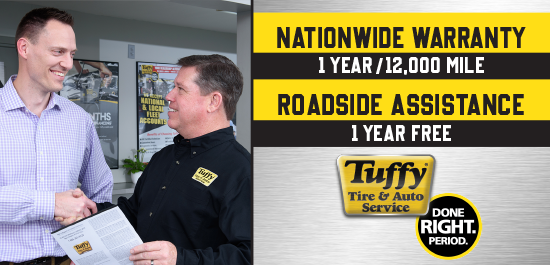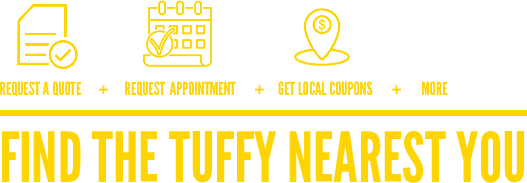Tuffy Dictionary
At Tuffy, we want our customers to completely understand what’s wrong with their vehicles and what we can do to make it right. That’s why we developed a list of commonly used language regularly spoken inside the shop. Some may be a little basic to you, some may not. We made it straightforward and to-the-point to save you time. So read on. And don’t ever be afraid to ask questions when you visit us. Our automotive technicians have the answers and are glad to share.
- ABS - Antilock braking system. ABS is a computer-controlled system that prevents your vehicle’s brakes from locking up and the tires from skidding during hard braking.
- Adaptive Cruise Control - The special system that automatically slows your vehicle to avoid front-end collisions.
- Additives - Chemicals that are added to the engine, cooling system, air conditioning system or transmission to maintain or enhance performance.
- Air Conditioning Compressor - This compressor is the power unit of the air conditioning system that puts the refrigerant under high pressure before it pumps it into the condenser, where it changes from a gas to a liquid.
- Air Conditioning Condenser - This is positioned between your vehicle’s grille and the engine cooling radiator in which the gaseous refrigerant sheds heat and returns to a liquid state. The liquid refrigerant flows to the evaporator inside the dashboard, where it cools the cabin.
- Air Conditioning Evaporator - This resides inside your vehicle’s dashboard and provides cold air for the air conditioning system. It’s called the evaporator because it’s where the freezing liquid refrigerant takes on any heat from the air blown through it and changes into a gaseous state (evaporating it) before returning it to the air conditioning condenser to shed the heat; the process is constantly repeated. The air that emerges from the air conditioner is cold as a result.
- Air Conditioning System - The cooling system that started appearing in vehicles in 1970. Abbreviated as A/C, it uses refrigerant and a compressor to lower temperatures inside the vehicle to make the ride more comfortable.
- Air Filter - Commonly referred to as the engine air filter. This keeps debris from getting inside of your engine. Like all filters, it eventually clogs up and needs to be replaced.
- All-Wheel Drive (AWD) - In an all-wheel-drive car or crossover, the engine, transmission, and differential or differentials are configured to deliver power to all four wheels. This gives the vehicle more traction in slippery conditions and can help make it handle better. All-wheel drive is commonly called “AWD” and can be found in many car and crossover models. Notably, AWD systems tend to work with no driver decision making and are typically fully automatic.
- Alternator - This is a generator that produces electricity to power your vehicle’s ignition system, lights, and accessories. The engine drives the alternator by means of a belt, either with a dedicated belt or a belt shared with other pulley-driven components.
- ASE - Automotive Service Excellence. This is the common abbreviation for the nationally recognized organization that issues certifications to professionals in the automotive service industry.
- Automatic Transmission Fluid - Like other vital automotive fluids, transmission fluid deteriorates over time. Hard use, such as frequent stop-and-go city driving, hauling heavy loads, trailer towing - will accelerate the deterioration.
- Ball Joint - These act like hinges and connect the suspension control arms to the steering knuckles with a rotating, spherical stud and a socket, giving the wheels a wide range of movement -- from side to side for steering and up and down for going over bumps. Some vehicles have upper and lower front ball joints.
- Brake Caliper - This is the part of your vehicle’s braking system that provides a clamping force, responsible for stopping the vehicle. When you press the brake pedal, the brake caliper at each wheel squeezes the brake pads into the rotor, to generate friction, which slows the vehicle.
- Brake Fluid - This transfers the force of your foot pressing on the brake pedal to the brakes at all four wheels. Fluid-filled, air-free channels extend from the master cylinder in your vehicle’s engine compartment through brake lines (rigid tubes) and flexible hoses to cylinders that activate calipers or drum brakes. Some vehicles incorporate a warning light to indicate if the level drops too low. A healthy brake system won’t lose fluid, though the level may decrease as the brake pads wear.
- Brake Master Cylinder - This is the first component in your vehicle’s braking system and is activated by depressing the brake pedal. The pedal pushes a piston through this cylinder, forcing brake fluid through brake lines to slave cylinders at each wheel, which in turn drive the pistons that force friction material against the wheel hubs, stopping the wheel. The master cylinder is designed to last the life of the car, but like brake calipers, sometimes it can spring leaks or otherwise fail, and it must be rebuilt or replaced. The master cylinder is topped by the brake-fluid reservoir, which must be kept full.
- Brake Pad - Sits between the brake caliper and the brake rotor. They’re made of a special material that creates the friction required to stop your vehicle, when the caliper clamps them against the rotor. Brake pads need to be changed regularly, as they wear out with use.
- Brake Rotor - Round metal disc bolted in behind your vehicle’s wheels. It spins at the same speed as the vehicle’s wheels. When braking is applied, the brake caliper squeezes the brake pads against the brake rotor, creating friction and stopping power. In many cases, your Tuffy automotive technician will need to change your brake rotors, as they wear out over time.
- Brake Shoes & Drum - With drum brakes, a hydraulic cylinder/piston complement between two brake shoes then pushes each shoe outward and into contact with the inner surface of the rotating drum. The brake shoe lining material creates friction against the drum, which slows and ultimately stops your vehicle’s wheel.
- Cabin Air Filter - This filters the air going into your heat and air conditioner system, keeping the components within clean and functioning properly. If your cabin air filter is clogged, your heat, defroster and air conditioner won’t work properly.
- Camshaft - The camshaft is a rotating shaft (or shafts) in an engine that activates the intake and exhaust valves for each cylinder. As the shaft turns, cams along its length press down on the spring-loaded valves in synchronicity with the motion of the pistons and firing of the spark plugs.
- Catalytic Converter - Your vehicle’s catalytic converter is located upstream of the muffler, close to the engine, and it changes environmentally damaging pollutants in the exhaust stream into more benign gases.
- Charging System - The charging system provides the electricity that powers your vehicle’s starter motor and runs electrical accessories, such as lights, audio system, air conditioner, window defroster and other components. Its main parts are the battery, alternator, and voltage regulator.
- Chassis - A blanket description of the base frame of your vehicle and the mechanical parts that are attached to it, including the power train and suspension.
- Check Engine Dashboard Light - This warns drivers that something is wrong and occurs when the computer issues an error message. A solid light means that the issue is not urgent. A flashing light means stop immediately, as soon as it's safe to stop.
- Climate Control - The term used to refer to the heater, air conditioner, and defrosting mechanisms in your vehicle. Some vehicles have advanced systems that detect outdoor temperatures and can be adjusted accordingly.
- Clutch - This operates behind the scenes in many transmissions, including automatics, but the word clutch typically refers to the component that connects and disconnects the engine’s rotating crankshaft to a traditional manual transmission. It disconnects when the driver depresses the clutch pedal, selects a gear using the stick shift and re-engages when the pedal is released.
- Coolant - Also called antifreeze, this combination of ethylene glycol and water protects the climate control system by dispersing excess heat and preventing parts from freezing.
- Computerized Alignment - When a Tuffy technician gives your vehicle an alignment, they are adjusting various parts to help ensure the wheels and tires are pointed perfectly straight down the road, improving fuel economy, safety, and handling. Every once in a while, a vehicle needs an alignment, especially after hitting a big pothole, which can also damage a tire, or wheel.
- Crankshaft - This is the hardened-steel shaft running the length of the engine that converts the linear force of the moving pistons into rotational force.
- Cylinder Head Gasket - This provides a seal between the engine block and the head that caps the cylinders. The gasket not only contains the pressure of controlled explosions within the cylinders but also isolates the cylinders, oil, and cooling channels from each other.
- Differential - Is a component used in some vehicles to take power from the transmission and deliver it to the wheels. Most commonly, you’ll find a differential in rear-wheel-drive vehicles, like sports cars and pickup trucks.
- Drivability - How smoothly your vehicle accelerates and idles. Drivability also refers to how well your vehicle starts at different temperatures and its ability to adapt to various driving conditions.
- Drive Belt - Reinforced rubber drive belts allow the engine’s rotating crankshaft to drive components such as water pumps, alternators, air-conditioning compressors, power-steering pumps or superchargers. The vehicle may use separate belts for one or more components or hit multiple pulleys with a snaking serpentine belt.
- Drivetrain - All of the parts of your vehicle that work together to deliver power to the wheels. The components differ depending on the type of vehicle (manual, automatic transmission, front-wheel or four wheel-drive). Your vehicle’s engine is not considered a part of the drivetrain.
- Emissions - An assessment of how many pollutants your vehicle gives off that is measured by EPA standards. Emissions of common gasses must not exceed the maximum levels set by the EPA.
- Engine - This is the heart of the vehicle, and it generates the power a vehicle uses to achieve the miracle of motion. Also called a motor or powerplant, engines are expressed in terms of their displacement (size), layout (shape), and number of cylinders. Generally, the more cylinders and larger sizes mean an engine is more powerful.
- Engine Oil Dashboard Light - This dashboard light illuminates when there's been a loss of oil pressure in your vehicle.
- Exhaust Manifold - This is bolted directly to your vehicle’s engine block. The exhaust manifold is the first section of a vehicle’s exhaust system. It funnels exhaust gases from all the cylinders and routes them to the car’s catalytic converter.
- Four-Wheel Drive (4WD) - Sometimes called 4x4 or 4WD, four-wheel drive has the same traction-enhancing goal as all-wheel drive (AWD), but it works differently. Usually, a 4x4 or four-wheel drive system requires the driver to activate four-wheel traction, via a button or lever. It’s more common in pickup trucks and larger SUV models.
- Front-Wheel Drive (FWD) - In a front-wheel drive vehicle, the engine only drives the front wheels. Many mainstream cars and minivans are front-wheel drive.
- Fuel Filter - This traps debris that could clog or damage the fuel injectors or engine in your vehicle. Fuel filters are usually located in the fuel line where it meets the fuel injection system at the engine or just in front of the rear wheels attached to the frame, but some vehicles use a filter only in the fuel tank itself.
- Fuel Injection - A system that delivers a high-pressure fuel stream in an internal combustion engine.
- Fuel Pump - This sends fuel from the gas tank to the engine. In modern cars, fuel pumps are usually electrically powered and located directly in or on the fuel tank.
- Gearbox - The system of gears controlled by the manual or automatic shifter in your vehicle. The movement of the gears directly influences the movement of the vehicle. Various driving conditions, like cruising on level surfaces, or climbing a hill, use different gear setups.
- Handling - How well your vehicle moves on straightaways, around corners and over varying degrees of terrain.
- Heater Core - The heater core warms your vehicle’s cabin using hot coolant from the engine. The cooling system’s hoses circulate liquid coolant through the heater core as they do through the engine and large cooling radiator behind the vehicle’s grille.
- Horsepower - Is the go-to, commonly accepted figure that expresses how powerful a vehicle’s engine is. Telling someone how much horsepower your vehicle has is like flexing your biceps when someone asks how strong you are.
- Ignition Coil - The ignition coil converts your vehicle’s 12 volts to the more than 10,000 volts required to produce an effective spark in the spark plugs, which in turn ignite the air-fuel mixture in an engine’s cylinders.
- Ignition Lock Cylinder - The ignition lock cylinder is a mechanical part where the ignition key is inserted to start a vehicle. It’s mounted inside the ignition switch, the electrical component that locks the ignition and “reads” anti-theft coding in the key to allow the vehicle to start.
- Ignition Switch - Most drivers think of the ignition switch as the slot where they insert the key to start their car, but that’s actually the ignition lock cylinder. The ignition switch is a more complex electrical component that has to “read” anti-theft coding in the key before it will activate electrical systems in the vehicle so the vehicle can start or allow an automatic transmission to be shifted out of Park. On vehicles with push-button start, the ignition switch has to recognize the anti-theft code transmitted by the key fob before it will allow the engine to start.
- Ignition System - The system that generates a spark and controls the timing of the spark that is necessary to ignite the fuel-air mixture and start fuel combustion inside the engine.
- Mass Airflow Sensor - A device in the throttle body that helps the engine computer determine the proper air-fuel mixture by measuring the mass of the air flowing past it. Because a precise mixture is crucial to efficiency and clean combustion, this sensor accounts for differences in air density, which varies with temperature and altitude.
- NHTSA - National Highway Traffic Safety Administration. The agency that develops and administers educational, engineering and enforcement programs for safe vehicle use and cost-effective highway travel.
- Oil Filter - A canister that filters dirt and abrasive materials out of your vehicle’s oil.
- Oil Pan - The oil pan is attached to the bottom of the engine with bolts and is the reservoir for oil that gets pumped throughout the engine to lubricate, clean and cool moving parts.
- Oil Pump - The oil pump provides the force that delivers oil through galleries and passages around the engine. Oil pumps are usually either inside the oil pan and driven by a camshaft or outside the pan and driven by a crankshaft. When those engine parts start moving, the pump starts working at the same time to pump oil to reduce friction and wear between moving parts and prevent the engine from seizing.
- OEM - Original Equipment Manufacturers. Companies that supply parts and components for the production of motor vehicles.
- Oxygen Sensor - As the name suggests, oxygen sensors in your vehicle’s exhaust system check for oxygen, the presence of which indicates incomplete combustion and unchecked pollution. This can trigger the check engine light. While oxygen sensors can faithfully diagnose improper engine operation, failed sensors are themselves among the most common causes of check engine light illumination.
- PCV Valve - Positive Crankcase Ventilation. This valve releases exhaust gas and unburned fuel from the engine block into the intake manifold. All engines allow some exhaust gases, unburned fuel and oil to “blow by” the pistons and collect in the crankcase where it produces sludge if not eliminated. Separating the crankcase from the intake manifold, which is a source of varying air pressure, the PCV valve maintains the optimal level of vacuum in the crankcase to extract the products of blow-by as well as potentially damaging moisture.
- Power Steering Pump - This pump pressurizes the hydraulic fluid that helps the driver turn the steering wheel.
- Powertrain - This system consists of the combination of the engine and transmission and is often protected by a manufacturer warranty.
- PSI - Pounds per square inch. A measurement of pressure most often used to ensure that tires are properly inflated.
- Pull - Pulling is a sign you need a wheel alignment. Pulling occurs when your steering wheel is turning to the left or right on its own while you attempt to steer straight ahead.
- Radiator - The radiator is the hub for all activity for your vehicle’s engine’s cooling system - the mixture of antifreeze and water that cools the engine continually passes through the radiator, where it discharges some of the heat it picked up from the engine and takes in cooler air before circulating again through passages around the engine. A spur line sends warm coolant to the heater core to generate heated air for the interior when needed. A water pump circulates the coolant around the engine, and a thermostatically controlled fan behind the radiator turns on as needed to draw more air through the radiator to help cool the antifreeze/water mixture.
- Rear-Wheel Drive (RWD) - In a rear-wheel drive vehicle, the engine only drives the rear wheels. This is more common in sportier vehicles.
- Shock Absorber - The “shock” is a suspension component that controls the up-and-down motion of a vehicle’s wheels. Though the devices provide some shock absorption, the job of absorbing shocks is handled mostly by the springs. More accurately called dampers, “shocks” damp excessive motion, keeping the vehicle’s body from bouncing down the road. Cars with worn-out shock absorbers illustrate what the devices are meant to do, because they tend to bounce continuously.
- Spark Plug - These screw into the top of an engine’s cylinders and create the electric spark required to ignite the compressed air-fuel mixture in your vehicle’s gas-powered engine. The right type of plug and the size of the gap between the electrodes at the tip are specified by the automaker, and using the right ones are crucial to proper performance.
- ‘Spongy Brakes’ - When your automotive technician tells you that your car has spongy brakes, he or she is referring to the brake pedal having little resistance when you press it down.
- Starter - The starter is an electric motor that uses power from the battery to turn the flywheel and crankshaft and start the engine. The crankshaft holds the connecting rods and pistons, so it requires a healthy starter motor and strong battery to move all that metal and get the engine going -- a job that’s more difficult in cold weather because the engine oil is thicker. Once the engine is running, the starter motor disengages.
- Strut - This is a type of shock absorber that has a structural role in a vehicle’s suspension. The strut includes a shock absorber element, but it also serves to position the wheels, a task handled by control arms in a conventional suspension design that employs dedicated shock absorbers. Like shocks, struts can lose their ability to damp bounces and compromise the car’s roadholding and braking.
- Supercharger - An air compressor driven by a belt attached to the engine. It works similarly to a turbocharger, with the same purpose of cramming more air and fuel into the engine for added horsepower and torque. Superchargers are less common than turbochargers in new vehicles and sometimes referred to as a blower.
- Sway Bar End Link - These are the attachment points between a sway bar and suspension members. Also known as a stabilizer bar or anti-roll bar, the sway bar connects suspension components on either side of the car to minimize body leaning in turns. Though the sway bars themselves are made of long-lasting, durable steel, the end links incorporate bushings that can fail with age and wear.
- ‘There’s Excessive Play In The…’ - This is mostly used as a reference to the steering or suspension components. It refers to a part that is either moving more than it should or moving when it shouldn’t.
- Thermostat - This cuts off the flow of coolant to the radiator when the engine is cold so that heat generated by the engine warms the coolant. Once the coolant warms to a specific level, a valve in the thermostat is supposed to open so that coolant flows through the radiator to cool off before being pumped back through the engine in a continuous cycle.
- Throttle Body - Your vehicle’s throttle body is a housing with a valve that regulates airflow into an engine’s intake manifold.
- Tie Rod - Tie rods connect the end of the steering rack to the steering knuckles on which the front wheels pivot when the steering wheel is turned. The tie rod has two sections threaded together, so their length can be adjusted and the front wheels aligned.
- Timing Belt - This is a notched rubber belt, sometimes called a Gilmer belt. This belt allows the crankshaft to drive the camshaft, which in turn opens and closes the valves. Without this belt, the engine can't run.
- TPMS - Tire Pressure Monitoring System. This system more or less communicates when the tire pressure is low on one of your vehicle’s tires.
- Torque - This is another representation of engine power. It’s different than horsepower but related to it. Torque is the important figure when it comes to moving a heavy object, like a car, truck, or locomotive. It can be felt as that “pushed into your seat” sensation when the throttle is applied. All engines create both horsepower and torque, and horsepower is calculated, partly, using torque figures – but torque is a less popular measurement of power than horsepower is.
- Traction Control - This safety feature minimizes wheel spin and ensures good traction between the tires and the road when your vehicle accelerates. It activates when there is a mismatch between engine torque and throttle input.
- Transfer Case - On four-wheel-drive vehicles, the transfer case contains gears that connect a second drive shaft to send power to all four wheels instead of just the front or rear ones.
- Transmission - This is the part of a vehicle that turns the engine’s horsepower and torque into the driving force that turns the wheels. Usually, a transmission has between four and eight gears, or “speeds.” Most transmissions are manual or automatic, though other types exist. The transmission is connected to the engine on one side, and the wheels on the other. It may also be referred to as the gearbox.
- Turbocharger - an air compressor driven by an engine’s exhaust gasses. It crams more air and fuel into the engine, which makes the engine create more horsepower and torque. Turbochargers were once used mainly in performance car models, though they’re now more common in newer mainstream vehicles, as they can help save fuel. Many engines do not have a turbocharger. Some engines have one turbocharger and are often designated as turbo. Other engines have two turbochargers and are typically called twin turbo.
- VIN - Vehicle Identification Number. A unique number that sets a vehicle apart as unique. Digits within the number describe various aspects of your vehicle.
- Water Pump - This is powered by your vehicle’s engine and circulates liquid coolant through the engine cooling system. The water pump is driven by a belt (whether a dedicated serpentine or rarely by the timing belt), so proper belt maintenance is critical to its operation.
- Wheel - The round, metal provision that the tire is attached to. The tire (rubber) is mounted over the wheel (metal). Tires are not wheels, and wheels are not tires, even though both are round and spin.
- Wheel Bearing - Wheel bearings allow wheels to spin freely without generating excessive heat while supporting the weight of the vehicle. In addition, by reducing friction they improve fuel economy.




